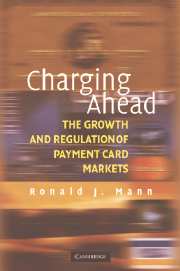Book contents
- Frontmatter
- Contents
- Figures and Tables
- Acknowledgments
- Introduction
- PART I THE BASICS OF PAYMENT CARDS
- PART II EASY MONEY
- PART III THE PUZZLE OF PAYMENT CARDS
- PART IV REFORMING PAYMENT SYSTEMS
- PART V OPTIMIZING CONSUMER CREDIT MARKETS AND BANKRUPTCY POLICY
- 15 Causation, Consumer Credit and Bankruptcy
- 16 Regulating Consumer Credit Markets
- 17 Consumer Bankruptcy Reform
- Conclusion
- Appendix: Country-Level Data
- Notes
- Bibliography
- Index
15 - Causation, Consumer Credit and Bankruptcy
Published online by Cambridge University Press: 06 July 2010
- Frontmatter
- Contents
- Figures and Tables
- Acknowledgments
- Introduction
- PART I THE BASICS OF PAYMENT CARDS
- PART II EASY MONEY
- PART III THE PUZZLE OF PAYMENT CARDS
- PART IV REFORMING PAYMENT SYSTEMS
- PART V OPTIMIZING CONSUMER CREDIT MARKETS AND BANKRUPTCY POLICY
- 15 Causation, Consumer Credit and Bankruptcy
- 16 Regulating Consumer Credit Markets
- 17 Consumer Bankruptcy Reform
- Conclusion
- Appendix: Country-Level Data
- Notes
- Bibliography
- Index
Summary
The ambiguity of the link between consumer credit and bankruptcy creates real challenges for policymakers. For example, academics have explored the likelihood that expansion of the bankruptcy discharge can both increase the demand for credit and decrease the supply. Similar work has considered the effect of bankruptcy exemptions on the supply and demand for credit. An important problem for either analysis, underscored by Tom Jackson, has been the likelihood that quasi-rational behavioral biases of consumers undermine the policy prescriptions one might draw from models focused on fully rational actors.
Historical and political economy perspectives, in contrast, focus on the possibility that the expansion of the supply of credit necessitates a broader discharge. Several writers, for example, have pointed out the progression from relaxation of consumer credit regulations in much of western Europe in the 1980s, to increased financial distress by consumers, and finally to the adoption of bankruptcy systems that offer an increasingly more accessible discharge. Political economists argue that globalizing economies must provide some form of relief (here, the bankruptcy discharge) for consumers who bear the adverse effects of the unforgiving competitive markets that globalization induces (here, those who borrow to the point of financial distress). Indeed, the United States appears to be unique in responding to rising levels of credit-induced financial distress by making the bankruptcy process less friendly to debtors.
- Type
- Chapter
- Information
- Charging AheadThe Growth and Regulation of Payment Card Markets around the World, pp. 179 - 187Publisher: Cambridge University PressPrint publication year: 2006

